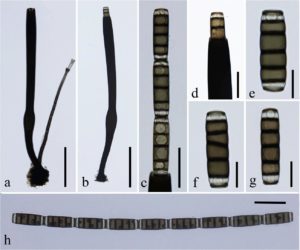Sporoschisma nigroseptatum D. Rao & R. Rao, Mycopathol Mycol Appl. 24(1): 82 (1964)
Index Fungorum number: IF 339563; Facesoffungi number: FoF 02377
Saprobic on submerged decaying wood. Sexual morph: Undetermined. Asexual morph: Colonies on the substratum superficial, effuse, hairy, black. Mycelium immersed, composed of pale to dark brown hyphae. Setae scattered, capitate, smooth, 0–3-septate, pale brown, becoming paler towards the subhyaline apex, straight or flexuous, 148 − 172 × 7–10 μm (x = 160×8.5 μm, n = 10). Conidiophores macronematous, mononematous, smooth, black, straight or slightly flexuous, solitary, with a cylindrical stipe and a swollen venter, erect, 336.5–387.5 μm long, 10.5–11.5 μm wide below venter and 12.5–15.5 μm wide above, 15–19 μm wide at venter. Conidiogenous cells monophialidic, integrated, terminal, lageniform, brown. Conidia catenate, doliiform, subtruncate at both ends, 40–45 × 11–12 μm (x = 42×11.5 μm, n = 35), 5-septate, smooth, with four inner cells dark brown and the two end cells hyaline to pale brown, with thick septa, the two central cells are longer than the penultimate cells, with conspicuous, spherical guttules in almost all cells.
Material examined – CHINA, Yunnan Province, saprobic on decaying wood submerged in a stream in Cangshan Mountain, March 2014, H.Y. Su, 3LQXM H 5–4 (DLU 629).
Notes – The fresh collection is collected from a stream in Cangshan Mountain, Yunnan, China, with morphological characters fitting well with S. nigroseptatum. Sporoschisma nigroseptatum has earlier been reported from Australia, India, Japan and New Zealand, but this is the first record for China.

